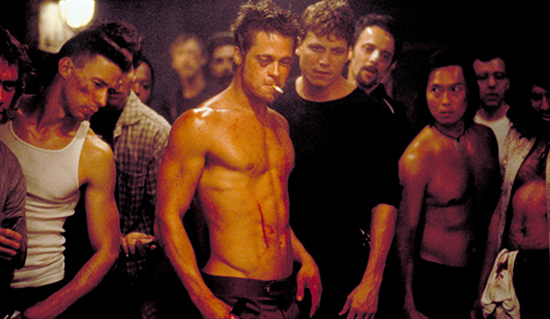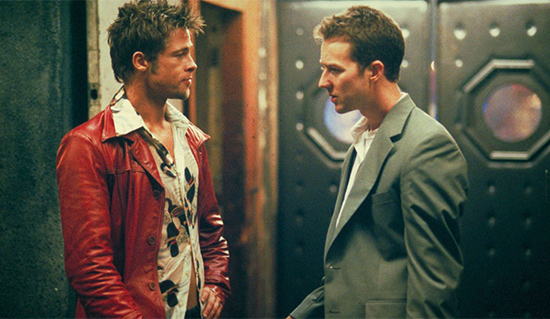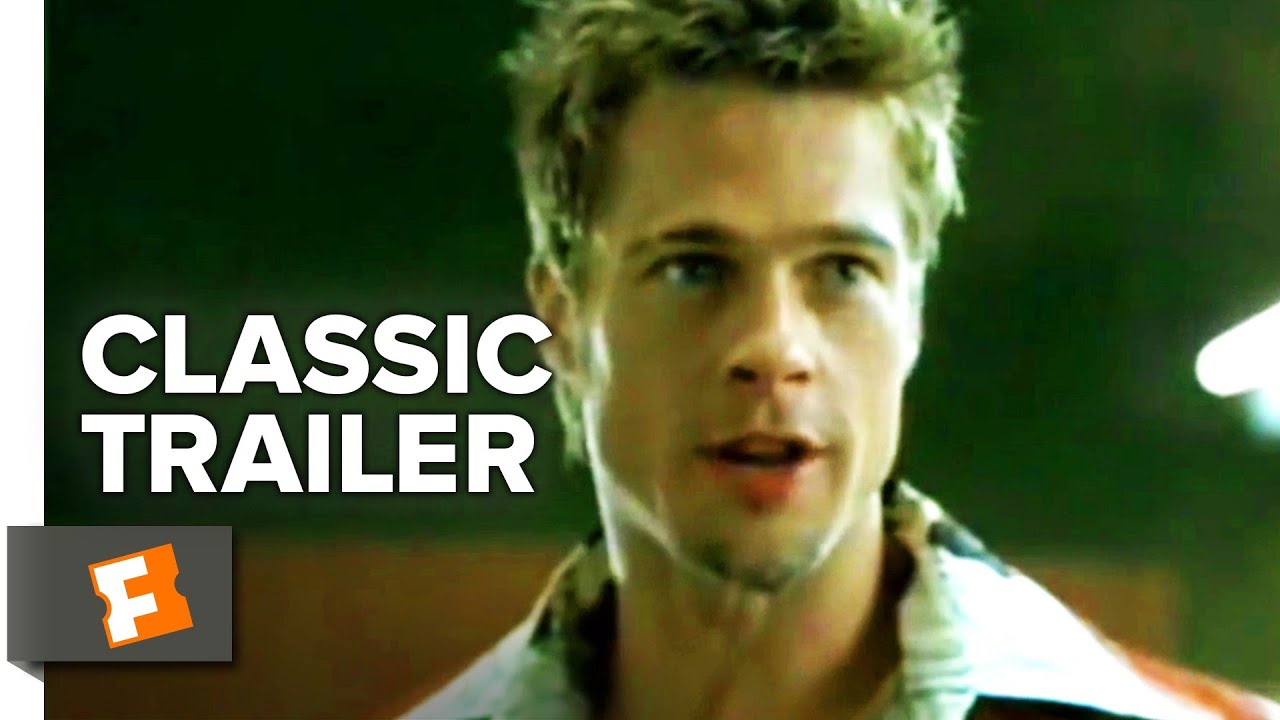The most banal thing one can say about David Fincher’s Fight Club, adapted by Jim Uhls from Chuck Palahniuk’s novel, in 2019 is that it both predicted and shaped our current political dystopia. In the years following the film’s release, the common misunderstanding that Tyler Durden is its hero and a source of wisdom – especially regarding the way American society has emasculated men, especially if they’re white and middle-class – seems to have become the way many now understand the film. The bad fans, to use TV critic Emily Nussbaum’s term, have taken it over. The obnoxious college student with Goodfellas, Scarface and Fight Club posters on his wall has become a cliche. Several women have told me they won’t answer personal ads from any man who says his favourite film is Fight Club.
An extremely talkative insomniac white-collar drone (Edward Norton, playing a nameless character only referred to as the Narrator) lives a life free of material want, but his alienation leads him to hang out at support groups every night, pretending to have a terminal illness or various addictions. On an airplane, he meets Tyler Durden (Brad Pitt), who re-directs his life in a more aggressive way. The two set up organized clubs where young men can re-connect with their physicality by fighting each other across their unnamed American city, which wind up supplying human fodder for Tyler’s Project Mayhem, a collective that goes in an anti-corporate direction with pranks that gradually become more dangerous and violent.
Chuck Palahniuk came out as gay in 2004. The clues are everywhere both in his book and Fincher’s film. In its opening minutes, the film cuts from the Narrator’s first mention of Marla (Helena Bonham Carter), the only substantial female character, to his embrace of Bob (Meat Loaf) at a support group for men with testicular cancer. The Narrator describes Bob’s “bitch tits”, which have developed as a result of his castration. We see little of this group, but the film mocks its embrace of sensitive masculinity. The idea that men should express their emotions is tied to them literally having their balls removed. The Narrator explains, “Bob loved me because he thought my testicles were removed too.”
Is Bob gay? Much later on, he joins Fight Club and sings its praises to the Narrator after running into him by chance on the street. The rules of Fight Club resemble a description of the closet: “The first rule of Fight Club is you do not talk about Fight Club.” These could be men talking about a gay bar before it was possible to speak openly about it. The homoeroticism of the relationship between Tyler and the Narrator is so obvious that it’s played for laughs, with references to sitcom couple Ozzie and Harriet. The final third’s darker overtones are foreshadowed by a scene where the Narrator lies in the hospital, getting stitched up after a fight. Tyler makes the same excuse as an abusive partner might, by saying that his friend fell down the stairs.
But of course, all this homoeroticism leads nowhere because Tyler and the Narrator are revealed to be the same person. This, and much of Bob’s storyline as well as the violence suffered by other members of various fight clubs, reinforces the long-running homophobic suggestion that gayness is inherently narcissistic.
The film could have taken other angles to continue its antihero’s queer path. But Bob and Angel Face (Jared Leto), a Fight Club cultist who can scrap but equally spends a lot of time trying to look pretty, get sidelined by the film. The man without testicles and huge breasts gets killed by a cop, after Project Mayhem sabotages a public sculpture of a giant ball. The Narrator feels threatened by his desire for Angel Face, whose femininity is signaled by his bleached blonde hair and eyebrows. In the film’s most brutal scene, the Narrator physically beats Angel Face till his face is a river of blood. The next time we see Angel Face, he’s still alive, but his left eye is entirely swollen shut, his nose seems to be broken and most of his face resembles a gruesome wound in the early stages of healing. The Narrator’s fear of his capacity for gayness leads him towards violence.

Marla is a Bummed-Out Punk Dream Girl – a Goth equivalent to the male fantasy of the Manic Pixie Dream Girl. Fight Club never has much interest in capturing her subjectivity. The film does a better job of finding compassion for a female character in the mere minute given to a woman with cancer at a support group, who pleads to anyone in the audience to have sex with her before she dies. This scene gets into difficult emotional territory rarely seen in mainstream cinema; in the media, the terminally ill are often stereotyped as asexual and avoid exposing their desire in ways that others might find embarrassing. But Marla goes from deliberately overdosing on tranquilizers and making glib jokes about having sex as a child, to cradling the Narrator’s wounds in the film’s final minutes. A subliminal image of a flaccid penis suggests a hollowness and projection of male desire underlying this crucial scene, but it still wraps up the film by heterosexualizing its characters. In fact, that seems like Marla’s only role; in one scene, Tyler passes her to the Narrator after sex, just as queer theorists have written about the way many heterosexual men use women sexually to cover up the fact that their emotional bonds lie with each other.
The appeal of being like Tyler Durden to certain guys is obvious. (The novel famously introduced the word “snowflake” into the political vocabulary, but its context is less often noted. In the film, Tyler says “you are not a unique snowflake” while ordering around a group of men working in his garden as an attempt at indoctrination). Fight Club makes being part of Project Mayhem, as opposed to the earlier brawls, look utterly unappealing – the iconography is drawn from the world of Nazi skinheads, and their pranks, while initially funny, grow increasingly worrying. Yet this part of the film has its real-life parallels – especially with the American far-right group the Proud Boys (with former Vice editor Gavin McInnes, who stepped down under fear of legal prosecution, as a Tyler Durden figure). Like in Fight Club, the Proud Boys have a set of rules for membership, including attacking leftists and refraining from masturbation.
Alt-right figures like McInnes, Jordan Peterson and Stefan Molyneux have often been likened to Durden – given the influence the film has had over their fans, they may have taken inspiration from it. However, Fight Club is upfront about the libidinal aspects of right-wing authoritarianism. The alienated young men it depicts want a father figure, but they’re also getting, to be crude, a daddy. The Narrator’s ideal man is also his object of desire. If Tyler Durden were a real person, the two men could have a relationship. While gay men are hardly free of temptation towards fascism (look at Roy Cohn, fictionalized in Tony Kushner’s play Angels in America and the subject of two recent documentaries, or the more recent case of Milo Yiannopolous), what if the sexual blockage Fight Club describes could be fulfilled? Or if it, at minimum, were willing to imagine apparent narcissism as real self-love?
Scholar David Greven has written about Fight Club as a film that uses homoerotic imagery only to reject it and reinforce heteronormativity, also linking the Narrator’s tired and worn appearance to 19th-century anti-masturbation rhetoric. However, its version of heterosexuality is incredibly unstable, always in danger of collapsing into a queerness that the film can’t bring itself to fully embrace or imagine. But to be generous, this instability, rather than sexism, may be the main reason Marla is such an unconvincing character. The Narrator sees himself in her when they first meet, because they have the same habit of spending all their time at support groups for problems they don’t have. He instantly despises her for this. As many people do in real life, he condemns her for his own negative qualities. But what if they exist because she’s a mirror of his flaws?
The Narrator refers to himself as a nice guy at one point. Even before the twist, it’s pretty obvious how self-serving that description is: he hates women and treats men cruelly, indulging in a brutal bout of gay panic. But once the audience understands the full extent of his complicity in violence, it seems that his dissociative mental illness allows him to create plausible deniability to himself about his ugly behaviour.
Long before anyone recognized that the Internet would allow alienated, conservative young men to radicalize themselves and become a nation of Timothy McVeigh and Anders Beiring Breivik wannabes, Fight Club, like Taxi Driver before it, spotted how angry white young men so often feel entitled to take out their alienation in violence. For all the systemic problems it brings up, its world is also devoid of real love. In 1999, the film raised questions about capitalism and masculinity which were then taboo in mainstream discourse. Watching it again 20 years later, after so many bros have adopted Tyler Durden as their guru, one wonders if there’s a hidden possibility for solutions for that alienation – contained in its suggestion of its characters’ unfulfilled queer potential.



